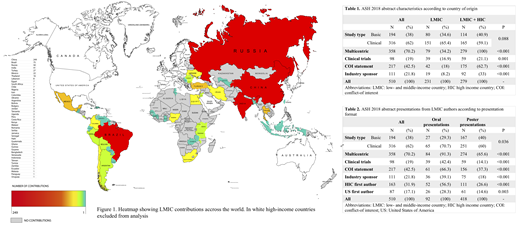Background. Establishing research capacity in low and middle-income countries (LMIC) is key for improving health systems and implementing actionable programs through evidence-based assessments. Few studies have analyzed hematology research capacity in LMICs. The American Society of Hematology (ASH) annual meeting is the largest hematology event where peer-reviewed contributions from researchers worldwide are selected for presentation based on scientific merit. Therefore, it can provide a useful snapshot of the current status of hematology research in a single point in time. For this reason, we analyzed abstracts presented at the 2018 ASH annual meeting (ASH18) with a focus on those from authors working in a LMIC.
Objective. To describe the proportion of abstracts presented at ASH18 from an LMIC and analyze their characteristics as a surrogate for academic contributions to global hematology.
Methods. We reviewed all abstracts presented at ASH18 in an oral presentation or poster form published online in the supplemental edition of Blood 2018;132 (Suppl 1). LMICs were selected according to the World Bank classification including countries or territories with a gross national income <$12,056 USD per capita. We described all abstracts that had a co-author with an affiliation from an institution in a LMIC, regardless of their position. We categorized studies as clinical vs. basic and single vs. multicenter nature. We also identified the presence of conflict-of interest statements (COI) and identifiable industry sponsors. We compared abstracts that had co-authors from high-income countries (HIC+LMIC) vs. those from LMIC countries alone. Comparison across groups was performed using chi-square and Fisher's exact test.
Results. A total of 4,871 abstracts presented at ASH 2018, with 1,026 oral presentations and 3,845 posters were available online. Among them, 510 abstracts (10.5%) had a contributing author from an institution in an LMIC, corresponding to 92 (9%) of all oral presentations and 418 (10.9%) of all posters (Figure 1). LMIC-only contributions represented 4.7% of all abstracts (n=229). The most common LMIC of origin for LMIC-only contributions was China with 133 (58.1%) (Figure 1). Most abstracts were clinical and multicentric in nature (62 and 70.2%, respectively), and in 42.5% of them a COI was reported. Clinical trials reflected 19% of all LMIC contributions. In 31.9% of cases the first author was affiliated to an institution in a HIC. Mixed LMIC/HIC contributions had significantly more COIs and industry sponsors than those from LMIC-only institutions (Table 1). When comparing between oral vs poster LMIC presentations, works selected for an oral presentation were significantly more clinical and multicentric, had a higher proportion of clinical trials, more COIs and identified industry sponsors (Table 2).
Conclusions. LMICs, where more than 80% of the world population resides, were responsible for only a small fraction of contributions to ASH18, half of them representing a form of international collaboration, with a high number of COI disclosures.
Gomez-Almaguer:Amgen: Consultancy, Speakers Bureau; Janssen: Consultancy, Speakers Bureau; Teva: Consultancy, Speakers Bureau; Takeda: Consultancy, Speakers Bureau; Celgene: Consultancy, Speakers Bureau.
Author notes
Asterisk with author names denotes non-ASH members.


